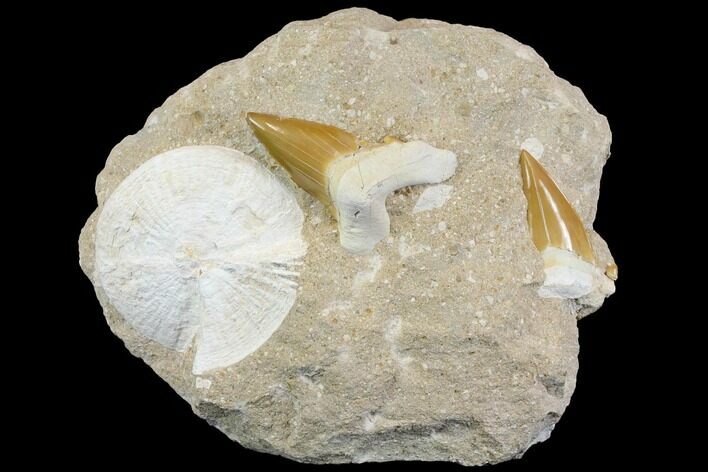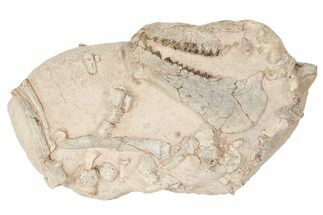This Specimen has been sold.
Two Very Large Otodus Shark Teeth in Rock - Morocco
This is a 8.9" wide specimen that contains two, very large teeth of the extinct giant mackerel shark, Otodus obliquus, collected from the phosphate deposits in the Oulad Abdoun Basin of Morocco. They are Eocene in age, or approximately 54 million years old. For the most part the teeth are in excellent condition, however there is a repaired crack through each tooth. There is a partial shark vertebra that has been exposed from the sandstone as well. This piece is natural and not a composite.
The largest tooth is 3.3" long. Comes with a display stand.
The largest tooth is 3.3" long. Comes with a display stand.
Otodus is an extinct mackerel (Lamniformes) shark that lived during the Eocene, approximately 54 million years ago. This is the same family of sharks that includes the Great White and the largest shark ever known, the Megalodon. These teeth are collected during phosphate mining operations near Khouribga, Morocco. While Otodus teeth are common fossils at these mines, large, good quality specimens are hard to find since they are often destroyed by the mining equipment.
The Kem Kem Group
The Kem Kem Group, also known as the Kem Kem Beds, is a significant geological formation located in southeastern Morocco, specifically in the region of the Anti-Atlas Mountains. This formation dates back to the late Cretaceous period, approximately 95 million years ago. The Kem Kem Beds are primarily composed of sandstone, siltstone, and claystone, interspersed with various sedimentary features that indicate a fluvial to deltaic environment.
The Kem Kem Group is renowned for its rich fossil deposits, which include a diverse array of prehistoric fauna. It has yielded a wide variety of dinosaur fossils, including theropods like Spinosaurus and Carcharodontosaurus, as well as large sauropod dinosaurs such as Rebbachisaurus. Additionally, the beds are home to many other fossilized creatures, including crocodiles, pterosaurs, fish, and a range of invertebrates.
Paleontologists consider the Kem Kem Group an important site for studying late Cretaceous ecosystems and the evolution of vertebrate life. The fossils found in this region have provided valuable insights into the diversity and behavior of prehistoric species, making it a key location for both scientific research and fossil collecting. The striking landscapes of the Kem Kem Beds, with their colorful rock formations and dramatic geological features, also attract geologists and tourists interested in the natural history of the area.
A paper on this assemblage can be found at: Vertebrate assemblages from the early Late Cretaceous of southeastern Morocco: An overview
The Kem Kem Group, also known as the Kem Kem Beds, is a significant geological formation located in southeastern Morocco, specifically in the region of the Anti-Atlas Mountains. This formation dates back to the late Cretaceous period, approximately 95 million years ago. The Kem Kem Beds are primarily composed of sandstone, siltstone, and claystone, interspersed with various sedimentary features that indicate a fluvial to deltaic environment.
The Kem Kem Group is renowned for its rich fossil deposits, which include a diverse array of prehistoric fauna. It has yielded a wide variety of dinosaur fossils, including theropods like Spinosaurus and Carcharodontosaurus, as well as large sauropod dinosaurs such as Rebbachisaurus. Additionally, the beds are home to many other fossilized creatures, including crocodiles, pterosaurs, fish, and a range of invertebrates.
Paleontologists consider the Kem Kem Group an important site for studying late Cretaceous ecosystems and the evolution of vertebrate life. The fossils found in this region have provided valuable insights into the diversity and behavior of prehistoric species, making it a key location for both scientific research and fossil collecting. The striking landscapes of the Kem Kem Beds, with their colorful rock formations and dramatic geological features, also attract geologists and tourists interested in the natural history of the area.
A paper on this assemblage can be found at: Vertebrate assemblages from the early Late Cretaceous of southeastern Morocco: An overview
SPECIES
Otodus obliquus
LOCATION
Oulad Abdoun Basin, Morocco
FORMATION
Phosphate Deposits
SIZE
8.9 x 7.2", Larger tooth 3.3"
CATEGORY
SUB CATEGORY
ITEM
#143930
We guarantee the authenticity of all of our specimens.
 Reviews
Reviews















